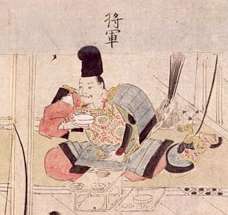Minamoto no Yoriyoshi
Minamoto no Yoriyoshi (源 頼義, 988 - August 27, 1075) was a head of Japan's Minamoto clan. Along with his son Minamoto no Yoshiie, he led the Imperial forces against rebellious forces in the north. This campaign would be called the Zenkunen War, and would be followed some years later by the Gosannen War.[1] His childhood name was Odaimaru (王代丸).

He held the title, passed down from his father, of Chinjufu-shōgun, Commander-in-chief of the Defense of the North.
Yoriyoshi accompanied his father Minamoto no Yorinobu[2] on his own missions to defend the Empire, quelling rebellions and disturbances. Thus he gained much of his knowledge of tactics and strategy. He fought in the Zenkunen War for twelve years starting in 1051, including the Battle of Kawasaki.[3] In 1063, Yoriyoshi founded Tsurugaoka Hachiman-gū in Kamakura[4] which was to become, roughly a century later, the primary shrine of the Minamoto clan when they began the Kamakura shogunate.
His son was Minamoto no Yoshiie, who "would go on to be admired by his contemporaries as the greatest warrior."[2]
In 1065, he ordained as a Buddhist monk and received the Dharma name Shinkai (信海).
Family
- Father: Chinjufu-shōgun Minamoto no Yorinobu
- Mother: Shuri no Myobu
- Wife: daughter of Taira no Naokata
- Concubine: Takichi Muneyori's daughter
- Children:
- Minamoto no Yoshiie by daughter of Taira no Naokata
- Minamoto no Yoshitsuna by daughter of Taira no Naokata
- Minamoto no Yoshimitsu by daughter of Taira no Naokata
- Kono Chikakiyo
- daughter married Taira no Masanari
- daughter married Kiyohara no Narihira/Shigehira
See also
References
- Sansom, George (1958). A history of Japan to 1334. Stanford University Press. pp. 249–251. ISBN 0804705232.
- Sato, Hiroaki (1995). Legends of the Samurai. Overlook Duckworth. pp. 74–75, 83–85, 95–109. ISBN 9781590207307.
- Turnbull, Stephen (1998). The Samurai Sourcebook. Cassell & Co. p. 199. ISBN 1854095234.
- 鶴岡八幡宮 "History of Tsurugaoka Hachiman Shrine" (in Japanese) retrieved on February 4, 2009
Sources
- Sansom, George (1958). 'A History of Japan to 1334'. Stanford, California: Stanford University Press.